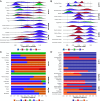Women's subsistence strategies predict fertility across cultures, but context matters
- PMID: 38346210
- PMCID: PMC10907265
- DOI: 10.1073/pnas.2318181121
Women's subsistence strategies predict fertility across cultures, but context matters
Abstract
While it is commonly assumed that farmers have higher, and foragers lower, fertility compared to populations practicing other forms of subsistence, robust supportive evidence is lacking. We tested whether subsistence activities-incorporating market integration-are associated with fertility in 10,250 women from 27 small-scale societies and found considerable variation in fertility. This variation did not align with group-level subsistence typologies. Societies labeled as "farmers" did not have higher fertility than others, while "foragers" did not have lower fertility. However, at the individual level, we found strong evidence that fertility was positively associated with farming and moderate evidence of a negative relationship between foraging and fertility. Markers of market integration were strongly negatively correlated with fertility. Despite strong cross-cultural evidence, these relationships were not consistent in all populations, highlighting the importance of the socioecological context, which likely influences the diverse mechanisms driving the relationship between fertility and subsistence.
Keywords: anthropological demography; cross-cultural analysis; demographic transition; fertility; subsistence-based populations.
Conflict of interest statement
Competing interests statement:The authors declare no competing interest.This article is a PNAS Direct Submission. J.H.J. is a guest editor invited by the Editorial Board.
Figures





Similar articles
-
A multi-level analysis of the determinants of fertility in the four regions of Thailand.Asia Pac Popul J. 1992 Mar;7(1):51-64. Asia Pac Popul J. 1992. PMID: 12343798
-
Fertility-mortality variations across LDCs: women's education, labor force participation, and contraceptive-use.Kyklos. 1994;47(2):209-29. doi: 10.1111/j.1467-6435.1994.tb02256.x. Kyklos. 1994. PMID: 12289880
-
[A study on the relationship between women's employment and fertility].Ingu Pogon Nonjip. 1988 Jul;8(1):34-57. Ingu Pogon Nonjip. 1988. PMID: 12281391 Korean.
-
Measuring the status of women.Asian Pac Popul Programme News. 1984;13(1):20-2. Asian Pac Popul Programme News. 1984. PMID: 12313053
-
A phylogenetic analysis of the relationship between sub-adult mortality and mode of subsistence.J Biosoc Sci. 1999 Jan;31(1):1-16. doi: 10.1017/s0021932099000012. J Biosoc Sci. 1999. PMID: 10081233 Review.
Cited by
-
Young adults' desired life tradeoffs: love first, sex last.Sci Rep. 2024 Aug 24;14(1):19680. doi: 10.1038/s41598-024-70742-7. Sci Rep. 2024. PMID: 39181945 Free PMC article.
-
Demography of grandmothering: a case study in Agta foragers.Proc Biol Sci. 2025 May;292(2046):20250385. doi: 10.1098/rspb.2025.0385. Epub 2025 May 14. Proc Biol Sci. 2025. PMID: 40359976 Free PMC article.
-
Alcohol consumption, life history and extinction risk among Raute hunter-gatherers from Nepal.Evol Hum Sci. 2024 Nov 11;6:e45. doi: 10.1017/ehs.2024.42. eCollection 2024. Evol Hum Sci. 2024. PMID: 39703941 Free PMC article.
-
Contemporary small-scale subsistence populations offer unique insights into human musculoskeletal health and aging.Sci Adv. 2024 Nov 8;10(45):eadq1039. doi: 10.1126/sciadv.adq1039. Epub 2024 Nov 8. Sci Adv. 2024. PMID: 39514654 Free PMC article. Review.
References
-
- Pennington R., “Hunter-gatherer demography” in Hunter-Gatherers: An Interdisciplinary Perspective, Panter-Brick C., Layton R., Rowley-Conwy P., Eds. (Cambridge University Press, 2001), pp. 170–204.
-
- Kelly R. L., The Lifeways of Hunter-Gatherers: The Foraging Specturm (Cambridge University Press, ed. 2, 2013).
-
- French J. C., Palaeolithic Europe: A Demographic and Social Prehistory (Cambridge University Press, 2021).
-
- Bocquet-Appel J.-P., When the world’s population took off: The springboard of the Neolithic Demographic Transition. Science 333, 560–561 (2011). - PubMed
-
- Bentley G. R., Jasienska G., Goldberg T., Is the fertility of agriculturalists higher than that of nonagriculturalists. Curr. Anthropol. 34, 778–785 (1993).

